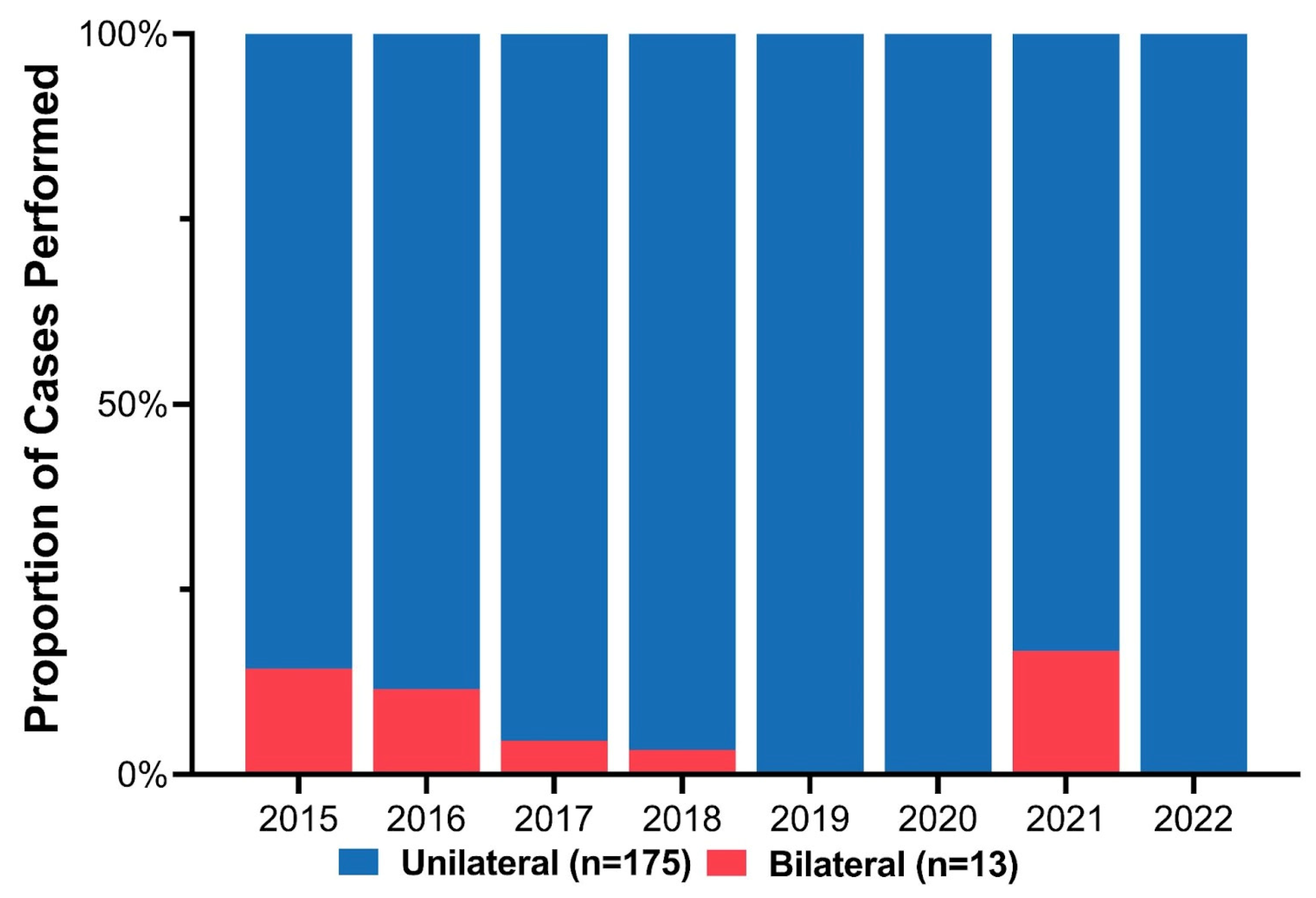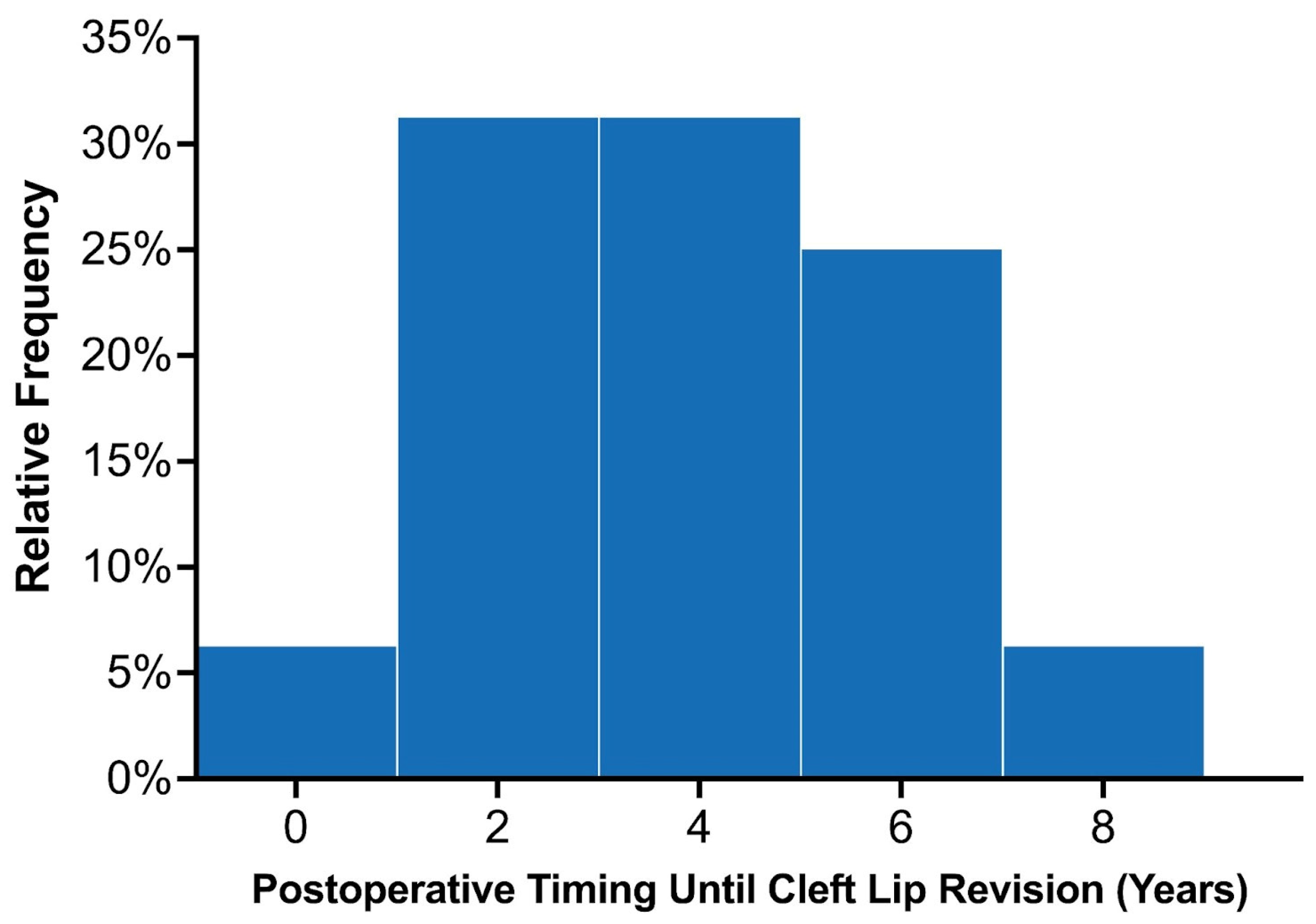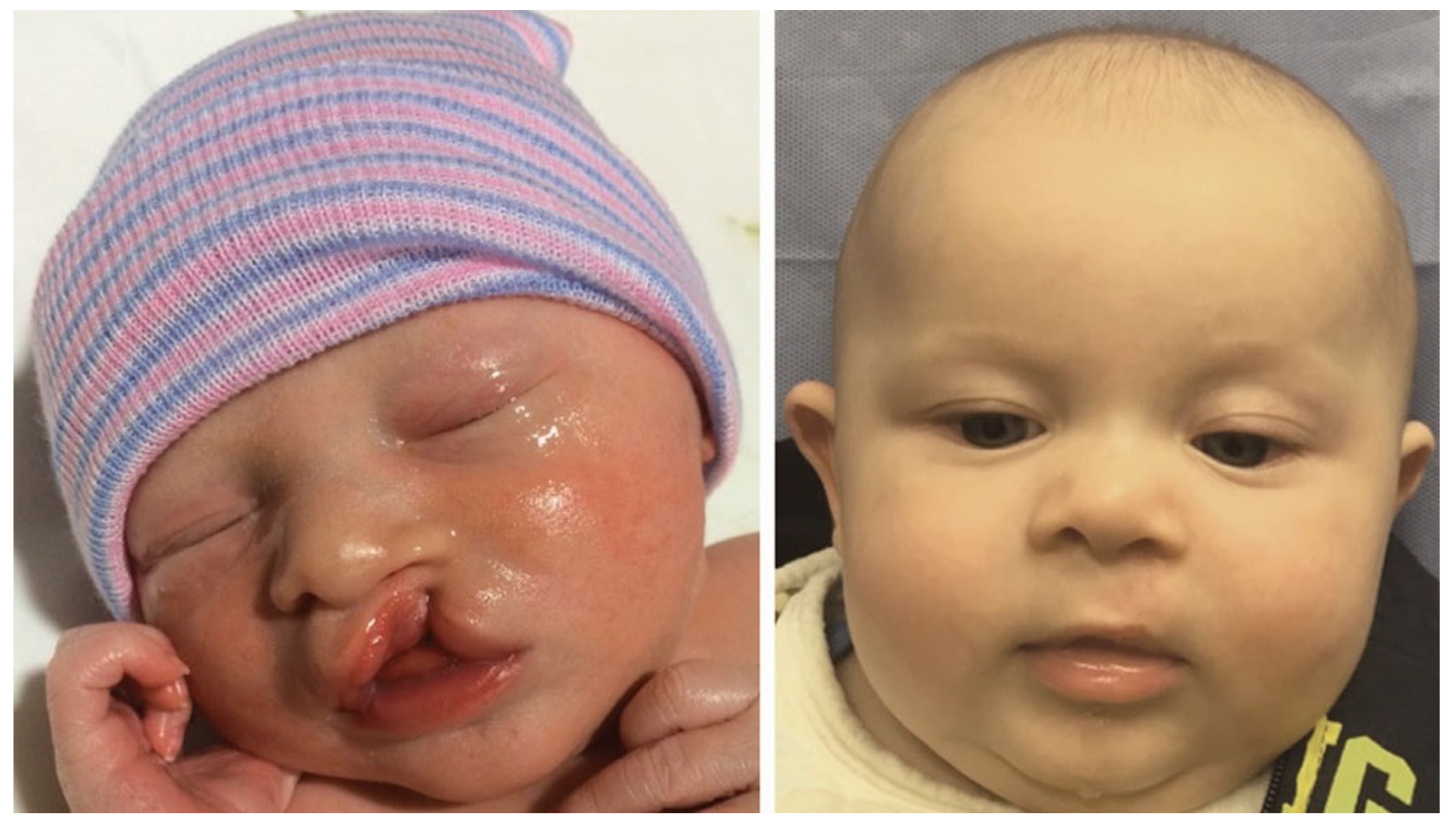Lessons Learned from a Single Institution’s Eight Years of Experience with Early Cleft Lip Repair
Abstract
:1. Introduction
2. Materials and Methods
2.1. Study Participants
2.2. Data Collection
2.3. Anesthesia Protocol
2.4. Operative Technique
- The anatomical landmarks of the lip and nose were delineated.
- a.
- Lip markings included:
- Height and depth of Cupid’s bow, lip length, wet–dry vermillion junction and the white roll.
- b.
- Nasal markings included:
- Columellar base, height of the philtral columns, nasal sill, alar bases, and the skin overlying the medial and lateral footplates of the lower lateral cartilage.
- c.
- Preoperative surgical markings are illustrated in Figure 2.
- 2.
- The total lip length was measured to allow us to design the flap.
- a.
- On the medial element, the lip length and the deficiency were measured.
- b.
- The lateral lip elements were delineated where the cutaneous aspect of the white roll began to converge with the vermillion-mucosal junction (i.e., Noordhoff point). A triangular-based flap was designed to allow for inset into the medial component.
- 3.
- Local anesthetic was administered via infraorbital nerve block in marked structures to avoid the distortion of native anatomy.
- 4.
- The initial incision was made using a 67 Beaver blade (Beaver-Visitec International, Abington, Oxfordshire, UK), along with a no. 15-blade for the mucosal side. The medial element was incised through the white roll and resected.
- 5.
- The orbicularis muscle was then identified and separated from the overlying dermis using a no. 69 Beaver blade. The incision was then carried cephalad to the base of the columella to release the aberrant attachments of the orbicularis muscle. On the lateral element, the laterally based triangle flap was incised meticulously to preserve the orbicularis muscle through the nonviable element of the cleft.
- 6.
- The aberrant attachments of the orbicularis muscle on the lower lateral cartilage were released, followed by resection of the cleft remnant off the lateral element.
- 7.
- A vestibular incision on the lateral element was created, initially perpendicular to the mucosa followed by supraperiosteal dissection.
- 8.
- The dissection continued cephalad to the nasal pyriform, where the residual nasal sill component of the cleft element was identified and ultimately resected.
- 9.
- A marginal incision was created on the cleft nasal side extending in a supra-cartilaginous fashion to the nasal radix.
- 10.
- After identifying the aberrant lower lateral cartilage, the cartilage was dissected and mobilized, with the removal of interdomal fat to further allow for cartilage elevation.
- 11.
- The anterior nasal spine was repositioned to midline and the nasal floor was reconstructed.
- 12.
- A modified McComb suture was then placed, extending from the upper lateral cartilage on the non-cleft side to the lower lateral cartilage on the cleft side.
- 13.
- A semi-rigid nasal stent was secured and left in place for four to six weeks postoperatively for cleft nasal cartilage molding.
2.5. Postoperative Care
2.6. Photogrammetric Analysis and Inclusion Criteria
2.7. Anthropometric Measurements
- Lip length—the distance from the lateral aspect of the columellar base to the ipsilateral peak of Cupid’s bow.
- Commissure length—the distance from the labial commissure to the trough of Cupid’s bow.
- Nostril width—the distance from the columellar base at its midpoint to the inner nostril at its most inferolateral point).
- Nostril breadth—the distance from the lateral aspect of the columellar base to the widest point of the nasal alae.
2.8. Statistical Analysis
3. Results
3.1. Patient Characteristics
3.2. Cleft Characteristics
3.3. Intraoperative and Postoperative Complications
3.4. Secondary Lip Revision
3.5. Anthropometric Outcomes
4. Discussion
Limitations and Future Directions
5. Conclusions
Author Contributions
Funding
Institutional Review Board Statement
Informed Consent Statement
Data Availability Statement
Conflicts of Interest
References
- DeFrances, C.J.; Cullen, K.A.; Kozak, L.J. National Hospital Discharge Survey: 2005 annual summary with detailed diagnosis and procedure data. Vital Health Stat. 2007, 13, 1–209. [Google Scholar]
- Kondra, K.; Stanton, E.; Jimenez, C.; Ngo, K.; Wlodarczyk, J.; Jacob, L.; Munabi, N.C.; Chen, K.; Urata, M.M.; Hammoudeh, J.A. Rethinking the Rule of 10s: Early Cleft Lip Repair Improves Weight Gain. Cleft Palate Craniofac J. 2023, 60, 306–312. [Google Scholar] [CrossRef] [PubMed]
- Wlodarczyk, J.R.; Wolfswinkel, E.M.; Liu, A.B.; Fahradyan, A.; Higuchi, E.; Goel, P.B.; Urata, M.M.M.; Magee, W.P.; Hammoudeh, J.A.M. Early Cleft Lip Repair: Demonstrating Efficacy in the First 100 Patients. Plast. Reconstr. Surg. 2022, 150, 1073–1080. [Google Scholar] [CrossRef] [PubMed]
- Hammoudeh, J.A.; Imahiyerobo, T.A.; Liang, F.; Fahradyan, A.; Urbinelli, L.; Lau, J.; Matar, M.; Magee, W.; Urata, M. Early Cleft Lip Repair Revisited: A Safe and Effective Approach Utilizing a Multidisciplinary Protocol. Plast. Reconstr. Surg. Glob. Open 2017, 5, e1340. [Google Scholar] [CrossRef]
- Kobus, K.; Kobus-Zaleśna, K. Timing of cleft lip and palate repair. Dev. Period Med. 2014, 18, 79–83. [Google Scholar]
- Greives, M.R.; Camison, L.; Losee, J.E. Evidence-based medicine: Unilateral cleft lip and nose repair. Plast. Reconstr. Surg. 2014, 134, 1372–1380. [Google Scholar] [CrossRef]
- Chow, I.; Purnell, C.A.; Hanwright, P.J.; Gosain, A.K. Evaluating the Rule of 10s in Cleft Lip Repair: Do Data Support Dogma? Plast. Reconstr. Surg. 2016, 138, 670–679. [Google Scholar] [CrossRef]
- Wilhelmsen, H.R.; Musgrave, R.H. Complications of cleft lip surgery. Cleft Palate J. 1966, 3, 223–231. [Google Scholar] [CrossRef]
- Nakajima, T.; Yoshimura, Y. Early repair of unilateral cleft lip employing a small triangular flap method and primary nasal correction. Br. J. Plast. Surg. 1993, 46, 616–618. [Google Scholar] [CrossRef]
- Mcheik, J.N.; Sfalli, P.; Bondonny, J.M.; Levard, G. Early repair for infants with cleft lip and nose. Int. J. Pediatr. Otorhinolaryngol. 2006, 70, 1785–1790. [Google Scholar] [CrossRef]
- Weatherley-White, R.C.; Kuehn, D.P.; Mirrett, P.; Gilman, J.I.; Weatherley-White, C.C. Early repair and breast-feeding for infants with cleft lip. Plast. Reconstr. Surg. 1987, 79, 879–887. [Google Scholar] [CrossRef]
- Gillham, J.C.; Anand, S.; Bullen, P.J. Antenatal detection of cleft lip with or without cleft palate: Incidence of associated chromosomal and structural anomalies. Ultrasound Obstet. Gynecol. 2009, 34, 410–415. [Google Scholar] [CrossRef] [PubMed]
- U.S. Infant Mortality Rate 1950–2023 n.d. Available online: https://www.macrotrends.net/countries/USA/united-states/infant-mortality-rate (accessed on 22 August 2023).
- Matsuo, K.; Hirose, T. Nonsurgical correction of cleft lip nasal deformity in the early neonate. Ann. Acad. Med. Singap. 1988, 17, 358–365. [Google Scholar] [PubMed]
- Erdmann, M.W.; Waterhouse, N. Neonatal cleft lip repair. J. R. Soc. Med. 1992, 85, 108–109. [Google Scholar] [CrossRef]
- Cannon, B. Unilateral cleft lip. N. Engl. J. Med. 1967, 277, 583–585. [Google Scholar] [CrossRef]
- Bromley, G.S.; Rothaus, K.O.; Goulian, D., Jr. Cleft lip: Morbidity and mortality in early repair. Ann. Plast. Surg. 1983, 10, 214–217. [Google Scholar] [CrossRef]
- Harris, P.A.; Oliver, N.K.; Slater, P.; Murdoch, L.; Moss, A.L.H. Safety of neonatal cleft lip repair. J. Plast. Surg. Hand Surg. 2010, 44, 231–236. [Google Scholar] [CrossRef] [PubMed]
- Hodges, A.M. Combined early cleft lip and palate repair in children under 10 months—A series of 106 patients. J. Plast. Reconstr. Aesthet. Surg. 2010, 63, 1813–1819. [Google Scholar] [CrossRef]
- Byrd, H.S.; Langevin, C.-J.; Ghidoni, L.A. Ear molding in newborn infants with auricular deformities. Plast. Reconstr. Surg. 2010, 126, 1191–1200. [Google Scholar] [CrossRef]
- Schiff, M.; Burn, H.F. The effect of intravenous estrogens on ground substance. Arch. Otolaryngol. 1961, 73, 43–51. [Google Scholar] [CrossRef]
- Kenny, F.M.; Angsusingha, K.; Stinson, D.; Hotchkiss, J. Unconjugated estrogens in the perinatal period. Pediatr. Res. 1973, 7, 826–831. [Google Scholar] [CrossRef] [PubMed]
- Uzuka, M.; Nakajima, K.; Ohta, S.; Mori, Y. The mechanism of estrogen-induced increase in hyaluronic acid biosynthesis, with special reference to estrogen receptor in the mouse skin. Biochim. Biophys. Acta 1980, 627, 199–206. [Google Scholar] [CrossRef] [PubMed]
- McComb, H.K.; Coghlan, B.A. Primary Repair of the Unilateral Cleft Lip Nose: Completion of a Longitudinal Study. Cleft Palate Craniofac. J. 1996, 33, 23–31. [Google Scholar] [CrossRef]
- McComb, H. Primary correction of unilateral cleft lip nasal deformity: A 10-year review. Plast. Reconstr. Surg. 1985, 75, 791–799. [Google Scholar] [CrossRef]
- Bennun, R.D.; Perandones, C.; Sepliarsky, V.A.; Chantiri, S.N.; Aguirre, M.I.; Dogliotti, P.L. Nonsurgical correction of nasal deformity in unilateral complete cleft lip: A 6-year follow-up. Plast. Reconstr. Surg. 1999, 104, 616–630. [Google Scholar] [CrossRef] [PubMed]
- Ariawan, D.; Vitria, E.; Sulistyani, L.; Anindya, C.; Adrin, N.; Aini, N.; Hak, M. Prevalence of Simonart’s band in cleft children at a cleft center in Indonesia: A nine-year retrospective study. Dent. Med. Probl. 2022, 59, 509–515. [Google Scholar] [CrossRef]
- Matsuo, K.; Hirose, T.; Otagiri, T.; Norose, N. Repair of cleft lip with nonsurgical correction of nasal deformity in the early neonatal period. Plast. Reconstr. Surg. 1989, 83, 25–31. [Google Scholar] [CrossRef] [PubMed]
- Wlodarczyk, J.R.; Wolfswinkel, E.M.; Fahradyan, A.; Rhee, C.; Liu, A.B.; Gibreel, W.; Magee, W.; Urata, M.M.; Hammoudeh, J.A.M. Nasoalveolar Molding: Assessing the Burden of Care. J. Craniofac. Surg. 2021, 32, 574–577. [Google Scholar] [CrossRef] [PubMed]
- Kimia, R.; Butler, P.D.; Guajardo, I.; Magee, L.; Lowe, K.; Scott, M.; Wes, A.; Jackson, O.A. Sociodemographic Factors That Influence the Choice to Pursue Nasoalveolar Molding: One Pediatric Hospital’s Experience. Cleft Palate Craniofac. J. 2020, 57, 1069–1077. [Google Scholar] [CrossRef]
- Esmonde, N.O.; Garfinkle, J.S.; Chen, Y.; Lambert, W.E.; Kuang, A.A. Factors Associated with Adherence to Nasoalveolar Molding (NAM) by Caregivers of Infants Born with Cleft Lip and Palate. Cleft Palate Craniofac. J. 2018, 55, 252–258. [Google Scholar] [CrossRef]
- Magyar, D.; Nemes, B.; Pálvölgyi, L.; Pulay, Z.; Nagy, K. The Burden of Care in Nasoalveolar Molding Treatment in Cleft Patients. Indian J. Plast. Surg. 2022, 55, 87–91. [Google Scholar] [CrossRef] [PubMed]
- Walker, N.J.; Anand, S.; Podda, S. Cleft Lip; StatPearls Publishing: Treasure Island, FL, USA, 2022. [Google Scholar]
- McCann, M.E.; de Graaff, J.C.; Dorris, L.; Disma, N.; Withington, D.; Bell, G.; Grobler, A.; Stargatt, R.; Hunt, R.W.; Sheppard, S.J.; et al. Neurodevelopmental outcome at 5 years of age after general anaesthesia or awake-regional anaesthesia in infancy (GAS): An international, multicentre, randomised, controlled equivalence trial. Lancet 2019, 393, 664–677. [Google Scholar] [CrossRef] [PubMed]
- Shukla, A.; Chowdhary, V. Neurodevelopmental outcome at 5 years of age after general anaesthesia or awake-regional anaesthesia in infancy (GAS): An international, multicentre, randomised, controlled equivalence trial. Acta Paediatr. 2019, 108, 2115–2116. [Google Scholar] [CrossRef] [PubMed]
- Miller, T.L.K.; Park, R.; Sun, L.S. Report on the Fifth PANDA Symposium on “Anesthesia and Neurodevelopment in Children”. J. Neurosurg. Anesthesiol. 2016, 28, 350–355. [Google Scholar] [CrossRef]
- Paradowska-Stolarz, A.; Mikulewicz, M.; Duś-Ilnicka, I. Current Concepts and Challenges in the Treatment of Cleft Lip and Palate Patients-A Comprehensive Review. J. Pers. Med. 2022, 12, 2089. [Google Scholar] [CrossRef]
- Galinier, P.; Salazard, B.; Deberail, A.; Vitkovitch, F.; Caovan, C.; Chausseray, G.; Acar, P.; Sami, K.; Guitard, J.; Smail, N. Neonatal repair of cleft lip: A decision-making protocol. J. Pediatr. Surg. 2008, 43, 662–667. [Google Scholar] [CrossRef]
- Broder, H.L.; Flores, R.L.; Clouston, S.; Kirschner, R.E.; Garfinkle, J.S.D.; Sischo, L.; Phillips, C. Surgeon’s and Caregivers’ Appraisals of Primary Cleft Lip Treatment with and without Nasoalveolar Molding: A Prospective Multicenter Pilot Study. Plast. Reconstr. Surg. 2016, 137, 938–945. [Google Scholar] [CrossRef]
- Shay, P.L.; Goldstein, J.A.; Paliga, J.T.; Wink, J.; Jackson, O.A.; Low, D.; Bartlett, S.P.; Taylor, J.A. A Comparative Cost Analysis of Cleft Lip Adhesion and Nasoalveolar Molding before Formal Cleft Lip Repair. Plast. Reconstr. Surg. 2015, 136, 1264–1271. [Google Scholar] [CrossRef]
- Murray, L.; De Pascalis, L.; Bozicevic, L.; Hawkins, L.; Sclafani, V.; Ferrari, P.F. The functional architecture of mother-infant communication, and the development of infant social expressiveness in the first two months. Sci. Rep. 2016, 6, 39019. [Google Scholar] [CrossRef]
- Burianova, I.; Kulihova, K.; Vitkova, V.; Janota, J. Breastfeeding After Early Repair of Cleft Lip in Newborns with Cleft Lip or Cleft Lip and Palate in a Baby-Friendly Designated Hospital. J. Hum. Lact. 2017, 33, 504–508. [Google Scholar] [CrossRef]
- López-Fernández, G.; Barrios, M.; Gómez-Benito, J. Breastfeeding and maternal attachment: The moderating roles of maternal stress and child behavior. J. Pediatr. Nurs. 2023, 69, e80–e87. [Google Scholar] [CrossRef]
- Tan, S.P.K.; Ganske, I.M.; Mulliken, J.B. Nasolabial Revisions in Unilateral Incomplete Cleft Lip: One Surgeon’s 28-Year Experience. Plast. Reconstr. Surg. 2020, 145, 1477–1485. [Google Scholar] [CrossRef] [PubMed]
- Zhang, Z.; Miyabe, M.; Morioka, D.; Nomura, M.; Tosa, Y.; Ohkubo, F.; Kadomatsu, K. Incidence of Secondary Lip Correction for Children with Unilateral Cleft Lip: A Single-Center Retrospective Study. Ann. Plast. Surg. 2019, 83, 424–428. [Google Scholar] [CrossRef] [PubMed]
- Sitzman, T.J.; Coyne, S.M.; Britto, M.T. The Burden of Care for Children with Unilateral Cleft Lip: A Systematic Review of Revision Surgery. Cleft Palate Craniofac. J. 2016, 53, 84–94. [Google Scholar] [CrossRef]
- Alfeerawi, S.B.; Roohani, I.B.; Trotter, C.B.; Choi, D.G.B.; Shakoori, P.M.; Fahradyan, A.; Urata, M.M.M.; Magee, W.P.M.; Hammoudeh, J.A. A Comparison of Revision Rates in Patients Undergoing Traditional Versus Neonatal Cleft Lip Repair. Plast. Reconstr. Surg. Glob. Open 2023, 11, 117. [Google Scholar] [CrossRef]
- Patel, P.A.; Rubin, M.S.; Clouston, S.; Lalezaradeh, F.; Brecht, L.E.; Cutting, C.B.; Shetye, P.R.; Warren, S.M.; Grayson, B.H. Comparative Study of Early Secondary Nasal Revisions and Costs in Patients with Clefts Treated with and Without Nasoalveolar Molding. J Craniofac Surg 2015, 26, 1229–1233. [Google Scholar] [CrossRef]
- Davidson, A.J.; Disma, N.; de Graaff, J.C.; E Withington, D.; Dorris, L.; Bell, G.; Stargatt, R.; Bellinger, D.C.; Schuster, T.; Arnup, S.J.; et al. Neurodevelopmental outcome at 2 years of age after general anaesthesia and awake-regional anaesthesia in infancy (GAS): An international multicentre, randomised controlled trial. Lancet 2016, 387, 239–250. [Google Scholar] [CrossRef]







| Patient Characteristic | Total n (%) | ||
|---|---|---|---|
| Total Number of Patients | 188 (100.0%) | ||
| Sex | |||
| Male | 104 (55.3%) | ||
| Female | 84 (44.7%) | ||
| Race | |||
| White/Caucasian | 97 (51.6%) | ||
| Asian | 19 (10.1%) | ||
| Black/African American | 3 (1.6%) | ||
| Other/Unreported | 69 (36.7%) | ||
| Ethnicity | |||
| Hispanic | 52 (27.7%) | ||
| Average GA-Corrected Age at Surgery | 1.0 ± 0.5 Month | ||
| Average Weight at Surgery | 4.1 ± 0.7 kg | ||
| ASA Classification | |||
| I | 45 (23.9%) | ||
| II | 143 (76.1%) | ||
| Pre-Term Birth | 8 (4.3%) | ||
| Cleft Phenotype | |||
| Isolated Cleft Lip | 89 (50.3%) | ||
| Cleft Lip and Palate | 88 (49.7%) | ||
| Cleft Laterality | |||
| Unilateral | 173 (93.1%) | ||
| Left | 109 (62.3%) | ||
| Right | 66 (37.7%) | ||
| Bilateral | 13 (6.9%) | ||
| Cleft Severity | |||
| Complete | 84 (48.0%) | ||
| Incomplete | 82 (46.9%) | ||
| Microform | 9 (5.1%) | ||
| Follow-Up Time | 3.1 ± 2.2 Years | ||
| Patient Characteristic | Total n (%) | Unilateral n (%) | Bilateral n (%) | ||
|---|---|---|---|---|---|
| Total Number of Patients | n = 188 | n = 175 | n = 13 | ||
| Total Lip Revisions | 22 (11.7%) | 20 (11.4%) | 2 (15.4%) | ||
| Major Revisions | 6 (3.2%) | 4 (2.3%) | 2 (15.4%) | ||
| Complete Takedown | 5 (2.7%) | 3 (1.7%) | 2 (15.4%) | ||
| Wound Dehiscence | 1 (0.5%) | 0 (0.0%) | 1 (7.7%) | ||
| Minor Revisions | 16 (8.5%) | 16 (9.1%) | 0 (0.0%) | ||
| Vermillion Asymmetry | 10 (5.3%) | 10 (5.7%) | 0 (0.0%) | ||
| White Roll Misalignment | 8 (4.3%) | 8 (4.6%) | 0 (0.0%) | ||
| Wet–Dry Junction Asymmetry | 8 (4.3%) | 8 (4.6%) | 0 (0.0%) | ||
| Short Lip | 4 (2.1%) | 4 (2.3%) | 0 (0.0%) | ||
| Intraoral Excess | 3 (1.6%) | 3 (1.7%) | 0 (0.0%) | ||
| Hypertrophic Scar | 1 (0.5%) | 1 (0.6%) | 0 (0.0%) | ||
| Anthropometric Distance from Ideal Symmetry | Preoperative | Postoperative | p-Value |
|---|---|---|---|
| Lip length 1 | 0.41 ± 0.16 | 0.13 ± 0.11 | <0.001 * |
| Commissure length 2 | 0.63 ± 0.59 | 0.14 ± 0.12 | <0.001 * |
| Nostril width 3 | 1.17 ± 0.97 | 0.23 ± 0.27 | <0.001 * |
| Nostril breadth 4 | 0.86 ± 0.79 | 0.16 ± 0.22 | <0.001 * |
Disclaimer/Publisher’s Note: The statements, opinions and data contained in all publications are solely those of the individual author(s) and contributor(s) and not of MDPI and/or the editor(s). MDPI and/or the editor(s) disclaim responsibility for any injury to people or property resulting from any ideas, methods, instructions or products referred to in the content. |
© 2023 by the authors. Licensee MDPI, Basel, Switzerland. This article is an open access article distributed under the terms and conditions of the Creative Commons Attribution (CC BY) license (https://creativecommons.org/licenses/by/4.0/).
Share and Cite
Roohani, I.; Trotter, C.; Shakoori, P.; Moshal, T.A.; Lasky, S.; Manasyan, A.; Wolfe, E.M.; Magee, W.P., III; Hammoudeh, J.A. Lessons Learned from a Single Institution’s Eight Years of Experience with Early Cleft Lip Repair. Medicina 2023, 59, 1741. https://doi.org/10.3390/medicina59101741
Roohani I, Trotter C, Shakoori P, Moshal TA, Lasky S, Manasyan A, Wolfe EM, Magee WP III, Hammoudeh JA. Lessons Learned from a Single Institution’s Eight Years of Experience with Early Cleft Lip Repair. Medicina. 2023; 59(10):1741. https://doi.org/10.3390/medicina59101741
Chicago/Turabian StyleRoohani, Idean, Collean Trotter, Pasha Shakoori, Tayla A. Moshal, Sasha Lasky, Artur Manasyan, Erin M. Wolfe, William P. Magee, III, and Jeffrey A. Hammoudeh. 2023. "Lessons Learned from a Single Institution’s Eight Years of Experience with Early Cleft Lip Repair" Medicina 59, no. 10: 1741. https://doi.org/10.3390/medicina59101741
APA StyleRoohani, I., Trotter, C., Shakoori, P., Moshal, T. A., Lasky, S., Manasyan, A., Wolfe, E. M., Magee, W. P., III, & Hammoudeh, J. A. (2023). Lessons Learned from a Single Institution’s Eight Years of Experience with Early Cleft Lip Repair. Medicina, 59(10), 1741. https://doi.org/10.3390/medicina59101741





